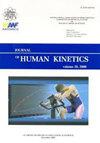Effects of Different Recovery Duration on External and Internal Load Measures during Bouts of Small-Sided Games
IF 1.9
3区 医学
Q2 SPORT SCIENCES
引用次数: 0
Abstract
The aim of this study was to analyse the effects of different recovery times between bouts of small-sided games (SSG) on external and internal load variables in semi-professional soccer players. Sixteen male semi-professional soccer players performed three 4 vs. 4 + goalkeeper SSG training sessions, each with different recovery bout duration: short (1 min) (SSG1), medium (2 min) (SSG2), and long (4 min) (SSG4). Time motion and neuromuscular measures were collected during all SSGs, in addition, the rating of perceived exertion (RPE) was determined at the end of the last bout of each SSG. Results showed a significant increase in the total number of accelerations (p = 0.016, ES = 0.97, large) and decelerations (p = 0.022, ES = 0.81, large) in SSG4 compared to SSG1. In terms of the internal load, SSG2 showed significantly higher RPE values (p = 0.011, ES = 1.00, large) in comparison with SSG1. If the sessions’ focus is on neuromuscular training, longer recovery times between SSG bouts should be used. Conversely, if the aim is to reach a higher total and running distance at different intensities, a 2-min recovery period between bouts may be more appropriate.小面游戏回合中不同恢复时间对外部和内部负荷测量的影响
本研究的目的是分析半职业足球运动员小面比赛(SSG)之间不同的恢复时间对外部和内部负荷变量的影响。16名男性半职业足球运动员进行了3次4对4 +守门员SSG训练,每次训练的恢复时间不同:短(1分钟)(SSG1)、中(2分钟)(SSG2)和长(4分钟)(SSG4)。在所有SSG期间收集时间运动和神经肌肉测量,并在每次SSG最后一轮结束时确定感知用力(RPE)评级。结果显示,与SSG1相比,SSG4的加速次数(p = 0.016, ES = 0.97,较大)和减速次数(p = 0.022, ES = 0.81,较大)均显著增加。在内负荷方面,SSG2的RPE值显著高于SSG1 (p = 0.011, ES = 1.00,较大)。如果训练的重点是神经肌肉训练,那么在两次SSG之间应该使用更长的恢复时间。相反,如果目标是在不同强度下达到更高的总距离和跑步距离,那么两次比赛之间的2分钟恢复期可能更合适。
本文章由计算机程序翻译,如有差异,请以英文原文为准。
求助全文
约1分钟内获得全文
求助全文
来源期刊

Journal of Human Kinetics
医学-运动科学
CiteScore
4.80
自引率
0.00%
发文量
83
审稿时长
3 months
期刊介绍:
The Journal of Human Kinetics is an open access interdisciplinary periodical offering the latest research in the science of human movement studies. This comprehensive professional journal features articles and research notes encompassing such topic areas as: Kinesiology, Exercise Physiology and Nutrition, Sports Training and Behavioural Sciences in Sport, but especially considering elite and competitive aspects of sport.
The journal publishes original papers, invited reviews, short communications and letters to the Editors. Manuscripts submitted to the journal must contain novel data on theoretical or experimental research or on practical applications in the field of sport sciences.
The Journal of Human Kinetics is published in March, June, September and December.
We encourage scientists from around the world to submit their papers to our periodical.
 求助内容:
求助内容: 应助结果提醒方式:
应助结果提醒方式:


